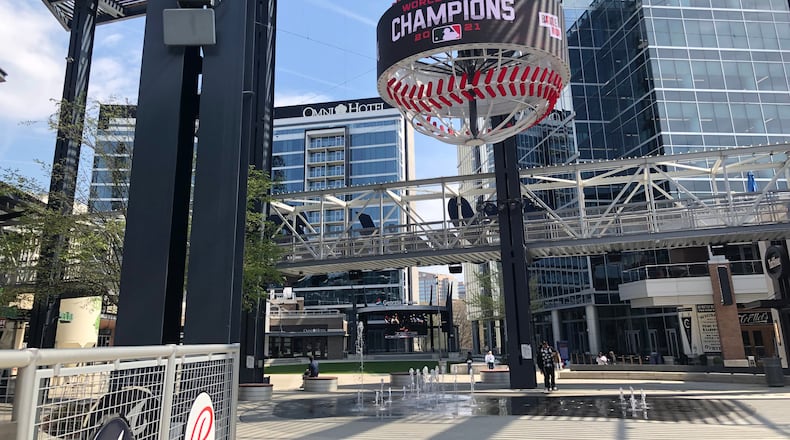The Atlanta Braves’ development arm is looking to build an office tower with Cobb taxpayer help, nearly a decade after the team’s management promised it would not seek any incentives for the mixed-use development surrounding its stadium — which was built with $300 million in public subsidies.
In a presentation to the Development Authority of Cobb County on Tuesday, representatives for the Braves and Truist Financial said they would seek a 10-year property tax break to help finance the cost of a $200 million, 250,000-square-foot office tower overlooking Truist Park.
Some board members said the request appeared to renege on promises made when Cobb County agreed to contribute $300 million to the stadium’s construction in 2013.
“One of the things that I recall when the Battery and the park were built was the promise that the Braves … would not come back and ask for additional abatements beyond what was already being provided to the ballpark,” said board member Karen Hallacy. “How does that fit into this coming in and the Braves basically asking for tax abatements on the property?”
However, Braves officials and the chairman of the county’s redevelopment authority disputed that a promise had been broken.
“We’re not asking for them (the tax breaks),” Mike Plant, the president of the Braves development arm replied. “Truist is.”
The Braves will own the office tower. Truist will lease space in it.
Truist earlier this month announced plans to relocate its securities division headquarters from Buckhead in north Atlanta to the office tower, which company officials say would be “300 feet from home plate.”
The Charlotte-based bank plans to bring at least 1,000 workers to the office, but many of them would not be new jobs for the Atlanta area. About 500 to 600 people work in the Buckhead office today, company representatives said Tuesday, and many would move to the new office.
A company spokesman previously told the AJC that the Buckhead office had 1,000 employees — all of whom would move to the Cobb office tower.
The Braves own the land, which is located on Battery Avenue, and would lease the building to Truist for 15 years, the company said previously.
The promise dates back to at least 2015, when Plant in a presentation said “We do not ask, nor do we intend to ask, for any incentives for the mixed-use part,” the AJC reported.
While Plant says the incentives are for its tenant, DACC Chair Clark Hungerford offered another reason the team didn’t break its promise: He said the office tower would technically be outside the 2 million square-foot mixed-use development known as The Battery.
“The commitment, if I’m not mistaken was for The Battery,” Hungerford said. “And this piece of property that we’re talking about, even though it’s close, it’s not the same piece of property.”
In an April 6 news release announcing the project, the Braves themselves said otherwise. The headline of the announcement proclaimed: “Truist and the Braves Development Company announce new national headquarters for Truist Securities inside The Battery Atlanta.”
On Tuesday, its board voted 5-2 to continue discussions with the two companies regarding the project, which calls for $140 million in construction work and $60 million in office furnishings and equipment. Hallacy and JC Bradbury voted against the resolutions.
It’s not yet clear how much the tax abatements would be worth. The DACC plans to complete a fiscal impact study to determine the costs and estimated benefits of a property tax break.
Another Battery-area office tower, built by TK Elevator, received about $15 million worth of tax abatements from the development authority on a $200 million project. Perfume manufacturer Arylessence this year is seeking a $1.4 million abatement on a $27 million expansion of its Northeast Cobb facility.
It’s also not clear how the tax abatements would affect Truist’s planned expansion.
Truist has already announced the relocation, and when asked by the board how the company would respond if the tax abatements were denied, a company official said it was only “one factor” that would determine the scope of the office project.
About the Author
Keep Reading
The Latest
Featured


